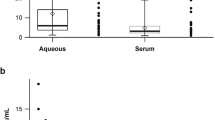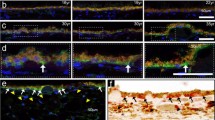Summary
The role of catecholamine (CA) in the pathogenesis and development of macular edema of central serous chorioretinopathy (CSC) was studied, and its relations with visual acuity were investigated. Plasma concentrations of epinephrine (E) and norepinephrine (NE) were determined in 30 consecutive eyes with CSC. Central macular thickness analysis was done by RTA and all the data were compared with normal eyes and analyzed with SAS software package. Plasma concentrations of E and NE were increased to (569±123) ng/L and (721±104) ng/L respectively in active CSC patients, significantly higher than those in normal subjects (P<0.01), and decreased to normal in convalescent stage. RTA analysis revealed that the retinal thickness of CSC patients was increased at active and recovery stage as compared with normal subjects; and the plasma concentration of E was significantly correlated with central macular thickness (t=2.173,P<0.05). Also, central macular thickness measured by RTA was significantly correlated with the visual acuity (r=−0.8046,P<0.001) in CSC eyes. RTA analysis might be useful to quantitatively detect and evaluate prognosis in CSC patients. The plasma concentration of E, which was highly correlated with macular edema, might play an important role in the early damage and the pathogenesis of CSC.
Similar content being viewed by others
References
Gass J M D. Pathogenesis of disciform detachment of the neuroepithelium: II. Idiopathic central serous choroidopathy. Am J Ophthalmol, 1967, 63:587
Yannuzzi L A. Type-A behavior and central serous choriortinopathy. Retina, 1987, 7:111
Yoshioca H, Katsume Y, Akune H. Experimental central serous chorioretinopathy in monkey eyes: fluorescein angiographic findings. Ophthalmologica, 1982, 185:168
Westerink B H, Bosker F J, O’Hanlon J F. Use of alumina, sephadex G10, and ion-exchange columns to purify samples for determination of epinephrine, norepinephrine, dopamine, homovanillic acid, and 5—hydroxyin-doleacetic acids in urine. Clin Chem, 1982, 28:1745
Zeimer R, Shahidi M, Mori M Tet al. A new method for rapid mapping of the retinal thickness at the posterior pole. Invest Ophthalmol Vis Sci, 1996, 37:1994
Oshima Y, Emi K, Yamanishi Set al. Quantitative assessment of macular thickness in normal subjects and patients with diabettic retinopathy by scanning retinal thickness analyzer. Br J Ophtalmol, 1999, 83:54
Christian Prünte, Josef Flammer. Choroidal capillary and venous congestion in central serous chorioretinopathy. Am J Ophthalmol, 1996, 121:26
Author information
Authors and Affiliations
Additional information
SUN Jinghua, male born in 1949, Associate Professor
This project was supported by Hubei Science Developmental Foundation (No. 20002P1705).
Rights and permissions
About this article
Cite this article
Jinghua, S., Junfeng, T., Zhitao, W. et al. Effect of catecholamine on central serous chorioretinopathy. Current Medical Science 23, 313–316 (2003). https://doi.org/10.1007/BF02829525
Received:
Published:
Issue Date:
DOI: https://doi.org/10.1007/BF02829525




